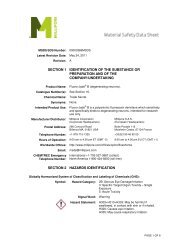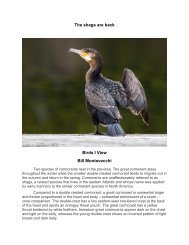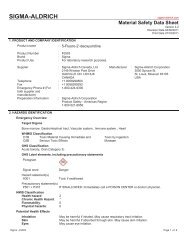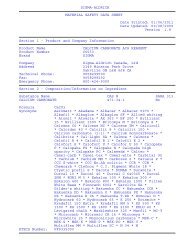Birds I View 125 - Out-foxed on Funk.pdf - Play Psych Mun
Birds I View 125 - Out-foxed on Funk.pdf - Play Psych Mun
Birds I View 125 - Out-foxed on Funk.pdf - Play Psych Mun
Create successful ePaper yourself
Turn your PDF publications into a flip-book with our unique Google optimized e-Paper software.
<str<strong>on</strong>g>Out</str<strong>on</strong>g>-<str<strong>on</strong>g>foxed</str<strong>on</strong>g> <strong>on</strong> <strong>Funk</strong> Island<br />
<str<strong>on</strong>g>Birds</str<strong>on</strong>g> I <str<strong>on</strong>g>View</str<strong>on</strong>g><br />
Bill M<strong>on</strong>tevecchi<br />
Fox trap or fox trot? Setting a live trap for an observant<br />
arctic fox <strong>on</strong> <strong>Funk</strong> Island. (photo: Chantelle Burke)<br />
Aerial photographs of <strong>Funk</strong> Island taken by the Canadian Wildlife Service earlier in the<br />
summer showing vacated breeding sites of murres assured us that there was a mammal <strong>on</strong> the<br />
island. As <strong>on</strong>e of our field crews had to aband<strong>on</strong> the Gannet Islands off Cartwright Labrador in<br />
late July, we hoped that we wouldn’t be meeting a bear <strong>on</strong> our research visit to <strong>Funk</strong>. Instead,<br />
we were greeted (literally) by the same arctic fox that was <strong>on</strong> the island last summer.<br />
The lack of sea ice during the spring precluded any opportunities for the fox to leave the<br />
island. Arctic foxes are migratory highly social animals. Being stuck <strong>on</strong> <strong>Funk</strong> Island is likely not<br />
the fox’s preferred alternative in winter and spring when the seabirds are away. Yet, for an<br />
arctic fox whose range extends northward to high polar regi<strong>on</strong>s, the harsh winter c<strong>on</strong>diti<strong>on</strong>s <strong>on</strong><br />
<strong>Funk</strong> Island may not be really all that challenging.<br />
Summer is another matter entirely. For an arctic fox that specializes <strong>on</strong> seabird eggs,<br />
chicks and adults, <strong>Funk</strong> Island is likely a paradise bey<strong>on</strong>d canid imaginati<strong>on</strong>.<br />
Efforts to trap the fox<br />
Having discussed the natural occurrence of arctic foxes <strong>on</strong> <strong>Funk</strong> and other coastal and<br />
offshore islands of Newfoundland and Labrador with NL Parks and CWS pers<strong>on</strong>nel, we decided<br />
to try to live trap the fox. Once <strong>on</strong> the island, I baited a large box-like metal cage with bis<strong>on</strong><br />
and polish sausage, capelin, a dead murre, some murre eggshells and a freshly killed murre<br />
chick that I got by chasing the fox away from it.
The fox took a few capelin without entering the trap fully but showed no interest in any<br />
of the other baits. He also to my surprise actually put a chewed up adult murre and a murre<br />
eggshell in the trap!<br />
More messages for the trapper were to follow. On our first evening <strong>on</strong> the island. I was<br />
awoken three times by a strange dream in which I was carrying a box of stinking rotten birds<br />
out of a basement. On the third awakening, I realized that the smell was a very real and intense<br />
<strong>on</strong>e – reminiscent of the spray of male cats. I am certain that Mr. fox was marking <strong>on</strong> the tent<br />
near the head of my cot. This was the <strong>on</strong>ly time in my life that I have been awakened from a<br />
deep sleep by a smell. I hope that it’s the last.<br />
C<strong>on</strong>sequences for the seabirds<br />
<strong>Funk</strong> Island’s offshore isolati<strong>on</strong> provides a natural refuge from land-based mammalian<br />
and avian predators. Here seabirds that normally nest <strong>on</strong> steep precipitous cliffs lay their eggs<br />
and raise their chicks <strong>on</strong> the level terrain of the island. This situati<strong>on</strong> makes <strong>Funk</strong> Island an easy<br />
place for us to access birds for research studies but also makes it a place where disturbance can<br />
be horrific.<br />
A free running fox besides killing and caching many birds truly terrorizes the lot of them.<br />
Here are some of the effects of Mr. fox. The largest fulmar col<strong>on</strong>y in Atlantic Canada has been<br />
aband<strong>on</strong>ed for the past 2 years. The puffins appear to have zero breeding success. Though a<br />
few razorbills had chicks, the massive murre col<strong>on</strong>y of more than a milli<strong>on</strong> birds had huge<br />
impacts. Perhaps 20% of the murre col<strong>on</strong>y was aband<strong>on</strong>ed, and breeding failure for those<br />
remaining may have been more than 50%. This totals to hundreds of thousands of murres.<br />
Even the large robust and aggressive gannets were showing signs of partial col<strong>on</strong>y<br />
aband<strong>on</strong>ment and breeding failures of likely greater than 50%. The c<strong>on</strong>sequences for our<br />
research have also been profound and costly – almost 50 murres carrying tracking devices have<br />
aband<strong>on</strong>ed their breeding sites. It is clear that the fox has to go.<br />
Next steps<br />
In September, we will return to <strong>Funk</strong> Island and will use a blowgun to attempt to hit the<br />
small fox with a tranquillizer dart. I hope it works and the animal can be brought to Salm<strong>on</strong>ier<br />
Nature Park. Otherwise, we will have a rifle.<br />
The irrati<strong>on</strong>ality of culling seals to enhance fish stocks (c<strong>on</strong>tinued)<br />
Dick Whitaker’s Ground Cover column “Seal culls and fisheries management” in the July<br />
issue of the Northeast Aval<strong>on</strong> Times necessitates a resp<strong>on</strong>se. Just the facts.<br />
Seals eat lots of fishes. They always have and always will. Seals eat many different<br />
species of fishes. They eat them in different places and at different times of year. Seals and the<br />
fishes that they eat do not exist in isolati<strong>on</strong> from the rest of the marine ecosystem. These<br />
circumstances combine to make arguments for culling based <strong>on</strong> incorrect and unfounded<br />
assumpti<strong>on</strong>s simply not credible.
Basing acti<strong>on</strong> <strong>on</strong> false assumpti<strong>on</strong>s generates mismanagement. We have great difficulty<br />
managing the direct effects of fisheries <strong>on</strong> fish stocks. Proposing the management of indirect<br />
effects through culling is not helpful. We are dealing with complex and dynamic marine<br />
ecosystems not farms.<br />
Killing thousands, tens of thousands, hundreds of thousands or even milli<strong>on</strong>s of seals<br />
will create lots of carnage. Such acti<strong>on</strong> will not result in more fishes in the nets of fishers.<br />
Rampant and destructive development in the community<br />
It was encouraging to see the Stop Order issued by the Portugal Cove – St. Philips Town<br />
Council <strong>on</strong> 23 June to stop an unpermitted road ripped in off of Emberly’s Road above Neary’s<br />
P<strong>on</strong>d in Portugal Cove. Yet there is so much to be c<strong>on</strong>cerned about.<br />
Heavy road c<strong>on</strong>structi<strong>on</strong> equipment is spreading over the meadows and landscapes.<br />
Wetlands are being infilled. The recent housing development <strong>on</strong> Portugal Cove Road looks like<br />
an envir<strong>on</strong>mental war-z<strong>on</strong>e.<br />
Having spent c<strong>on</strong>siderable time <strong>on</strong> Fogo Island during the past 2 years, it is absolutely<br />
astounding to see the ec<strong>on</strong>omic development that can be generated by truly investing in<br />
community heritage. Such investment instills pride as well as prosperity.<br />
Too many people in our communities <strong>on</strong> the Northeast Aval<strong>on</strong> are bent <strong>on</strong> or blind in<br />
throwing it all away. We have to stop “Paradising” own towns. It just does not pay in either the<br />
l<strong>on</strong>g or the short term. It absolutely essential that the Town Councils<strong>on</strong> the Northeast Aval<strong>on</strong><br />
act to protect our natural and cultural heritage.<br />
<str<strong>on</strong>g>Birds</str<strong>on</strong>g> in the area and around the province<br />
A number of dead gannets were found <strong>on</strong> the beach in Musgrave Harbour in July. These<br />
birds were likely discarded after being caught in and drowned in herring nets. Wilfred Williams<br />
of New Harbour in Trinity Bay provided me with a beautiful specimen of a gannet that drowned<br />
in <strong>on</strong>e of his herring nets. Interestingly, the gannet had a geo-locator attached to its leg. When<br />
Dave Fifield mapped the data, it showed that the gannet had wintered in the Gulf of Mexico<br />
and got out before the oil disaster, <strong>on</strong>ly to drown in a net in Trinity Bay.<br />
T<strong>on</strong>y Power had reports of oiled gannets <strong>on</strong> the water near Cape St. Mary’s but could<br />
not locate them in subsequent search (T<strong>on</strong>y Power). Roy J<strong>on</strong> emailed me a couple of photos of<br />
a black guillemot that he saw flying around the cliffs while he was hiking the Father Troy in<br />
Torbay.<br />
An American bittern crashed into the side of Joe Tilley’s new house <strong>on</strong> Three Island<br />
P<strong>on</strong>d Road in Flatrock. The specimen will be used with students at Memorial University. We<br />
have had lots of bird collisi<strong>on</strong>s with windows and houses over the years but this is the first I<br />
know of that involved such a large bird as a bittern.
Sizeable flocks of whimbrels were seen by Richard Northcott <strong>on</strong> the berry barrens of<br />
Ramea <strong>on</strong> 21 July. Herring gulls have successfully nested <strong>on</strong> the roof of the Science Building at<br />
Memorial University. They are making a racket. As they move into urban areas, we can expect<br />
more gulls nesting <strong>on</strong> building roofs. This is a comm<strong>on</strong> practice in urbanized areas in Europe.<br />
Keep looking. C<strong>on</strong>tacts = m<strong>on</strong>t@mun.ca, 895-2901 (home), 737-7673 (office).
















